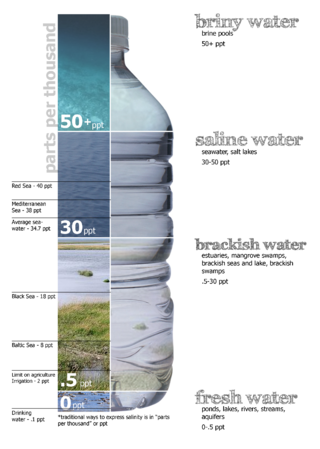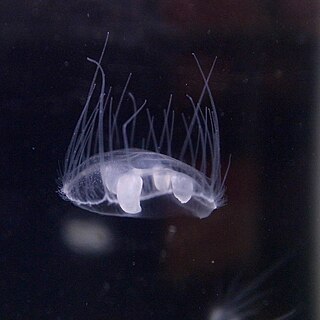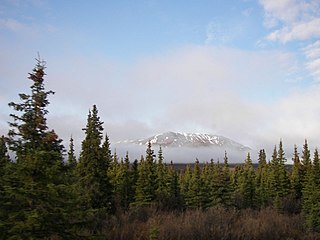
Brackish water, sometimes termed brack water, is water occurring in a natural environment that has more salinity than freshwater, but not as much as seawater. It may result from mixing seawater and fresh water together, as in estuaries, or it may occur in brackish fossil aquifers. The word comes from the Middle Dutch root brak. Certain human activities can produce brackish water, in particular civil engineering projects such as dikes and the flooding of coastal marshland to produce brackish water pools for freshwater prawn farming. Brackish water is also the primary waste product of the salinity gradient power process. Because brackish water is hostile to the growth of most terrestrial plant species, without appropriate management it can be damaging to the environment.

The Dominican Republic is a country in the West Indies that occupies the eastern five-eighths of Hispaniola. It has an area of 48,670 km2, including offshore islands. The land border shared with Haiti, which occupies the western three-eighths of the island, is 376 km long. The maximum length, east to west, is 390 km from Punta de Agua to Las Lajas, on the border with Haiti. The maximum width, north to south, is 265 km from Cape Isabela to Cape Beata. The capital, Santo Domingo, is located on the south coast.

The Republic of Haiti comprises the western three-eighths of the island of Hispaniola, west of the Dominican Republic. Haiti is positioned east of the neighboring island of Cuba, between the Caribbean Sea and the North Atlantic Ocean.

Hispaniola is an island between Cuba and Puerto Rico in the Greater Antilles of the Caribbean. Hispaniola is the most populous island in the West Indies, and the second-largest by land area, after Cuba. The 76,192-square-kilometre (29,418 sq mi) island is divided into two separate sovereign countries: the Spanish-speaking Dominican Republic (48,445 km2 to the east and the French and Haitian Creole–speaking Haiti (27,750 km2 to the west. The only other divided island in the Caribbean is Saint Martin, which is shared between France and the Netherlands.

Alfonso de la Cueva-Benavides y Mendoza-Carrillo, marqués de Bedmar was a Spanish diplomat, bishop and Roman Catholic cardinal. He was born in Bedmar, in what is now the province of Jaén. Alfonso was the son of Luis de la Cueva-Benavides, 2nd señor of Bedmar, and Elvira Carrillo de Mendoza y Cárdenas.

The Yuna River is the second longest river in the Dominican Republic, stretching for a length of 185.17 km. It forms within the Cordillera Central mountain range southwest of the city of Bonao in Monseñor Nouel Province, and passes through the fertile Cibao Valley. As the river courses north-northeast, it passes through the city of Bonao. Southwest of Cotuí, the river reaches Hatillo Dam before turning northeast then east as it reaches its mouth at the Samaná Bay in the northeast part of the Dominican Republic. Like many rivers in the Dominican Republic, the name is derived from the Taíno language.
At the time of first contact between Europe and the Americas, the Indigenous peoples of the Caribbean included the Taíno of the northern Lesser Antilles, most of the Greater Antilles and the Bahamas, the Kalinago of the Lesser Antilles, the Ciguayo and Macorix of parts of Hispaniola, and the Guanahatabey of western Cuba. The Kalinago have maintained an identity as an Indigenous people, with a reserved territory in Dominica.

Craspedacusta sowerbii or peach blossom jellyfish is a species of freshwater hydrozoan jellyfish, or hydromedusa cnidarian. Hydromedusan jellyfish differ from scyphozoan jellyfish because they have a muscular, shelf-like structure called a velum on the ventral surface, attached to the bell margin. Originally from the Yangtze basin in China, C. sowerbii is an introduced species now found throughout the world in bodies of fresh water.
Hemiboeckella powellensis is a zooplankton copepod of which only four of its kind have ever been observed. "Hemiboeckella" refers to this genus being similar to Boeckella, whilst "powellensis" refers to Lake Powell in Western Australia, the region it is endemic to. Its existence was initially recorded in May and June 1977, and has not been observed since.
Concurso Nacional de Belleza 1985 was held on May 5, 1984. There were 24 candidates who competed for the national crown. The winner of the Miss Dominican Republic title represented the Dominican Republic at the Miss Universe 1985. The Señorita República Dominicana Mundo entered Miss World 1985. The Señorita República Dominicana Café entered Reinado Internacional del Café 1985.
CCCAN is the Central American and Caribbean Swimming Federation. It is the body that organizes and overseas aquatic sports competitions in the Caribbean and Central American region. It is a member organization of UANA and affiliated to FINA.
Miss Tierra República Dominicana 2008 pageant was held at the Teatro La Fiesta Renaissance Jaragua Hotel & Casino in Bávaro, Dominican Republic, on June 17, 2008.

Freshwater biology is the scientific biological study of freshwater ecosystems and is a branch of limnology. This field seeks to understand the relationships between living organisms in their physical environment. These physical environments may include rivers, lakes, streams, ponds, reservoirs, or wetlands. Knowledge from this discipline is also widely used in industrial processes to make use of biological processes involved with sewage treatment and water purification. Water presence and flow is an essential aspect to species distribution and influences when and where species interact in freshwater environments.
With surface water resources of 20 billion m3 per year, of which 12 billion m3 are groundwater recharge, water resources in the Dominican Republic could be considered abundant. But irregular spatial and seasonal distribution, coupled with high consumption in irrigation and urban water supply, translates into water scarcity. Rapid economic growth and increased urbanization have also affected environmental quality and placed strains on the Dominican Republic's water resources base. In addition, the Dominican Republic is exposed to a number of natural hazards, such as hurricanes, storms, floods, Drought, earthquakes, and fires. Global climate change is expected to induce permanent climate shocks to the Caribbean region, which will likely affect the Dominican Republic in the form of sea level rise, higher surface air and sea temperatures, extreme weather events, increased rainfall intensity and more frequent and more severe "El Niño-like" conditions.

Lake Winnipeg has experienced excessive algae blooms since the 1990s. The lake's toxic blue-green algae has led to a deterioration of water quality, posing hazards to both human and animal ecosystems. The blooms are caused by high concentrations of nitrogen and phosphorus from fertilizer runoff and sewage draining into the lake via rivers and surface runoff.
Hugo Tolentino Dipp was a Dominican historian, politician, lawyer, educator, former Minister of Foreign Relations and President of the Chamber of Deputies of the Dominican Republic from 1982 to 1986.

Fresh water or freshwater is any naturally occurring liquid or frozen water containing low concentrations of dissolved salts and other total dissolved solids. The term excludes seawater and brackish water, but it does include non-salty mineral-rich waters, such as chalybeate springs. Fresh water may encompass frozen and meltwater in ice sheets, ice caps, glaciers, snowfields and icebergs, natural precipitations such as rainfall, snowfall, hail/sleet and graupel, and surface runoffs that form inland bodies of water such as wetlands, ponds, lakes, rivers, streams, as well as groundwater contained in aquifers, subterranean rivers and lakes.

The Taiga of North America is a Level I ecoregion of North America designated by the Commission for Environmental Cooperation (CEC) in its North American Environmental Atlas.












